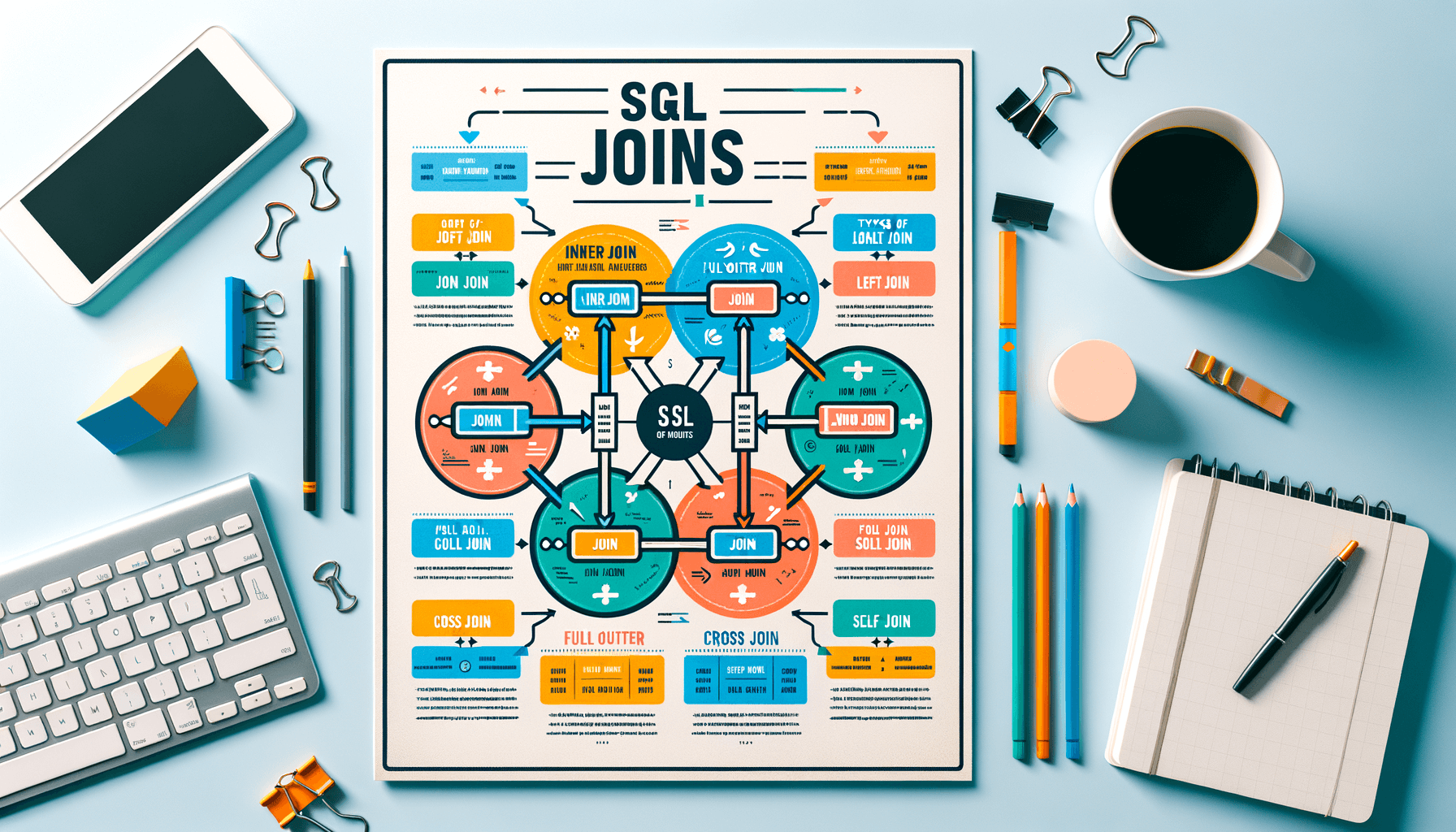A big variety of articles and resources

Mastering Data Management: The Ultimate SQL Training Guide
 Sia Author and Instructor
Learn SQL
Sia Author and Instructor
Learn SQL
14 minute read
SQL is a powerful tool for managing and analyzing data. Whether you're just starting out or looking to enhance your skills, mastering SQL can open up many opportunities. This guide will take you through the basics and into advanced topics, making you proficient in SQL.
Key Takeaways
- Understand the basics of SQL syntax and data types.
- Learn how to design and normalize databases effectively.
- Master advanced queries like subqueries, CTEs, and window functions.
- Optimize SQL performance with indexing and query execution plans.
- Ensure data integrity and security with constraints, triggers, and encryption.
Understanding SQL Fundamentals
Basic SQL Syntax
When starting with SQL, the first thing to learn is the basic syntax. SQL, or Structured Query Language, is used to communicate with databases. Understanding the basic commands like SELECT, INSERT, UPDATE, and DELETE is crucial. These commands allow you to retrieve and manipulate data stored in your database.
Data Types in SQL
In SQL, data types define the kind of data that can be stored in a table column. Common data types include INTEGER, VARCHAR, DATE, and BOOLEAN. Knowing the right data type to use is essential for efficient database design and operation.
Primary Keys and Foreign Keys
Primary keys and foreign keys are fundamental concepts in SQL. A primary key uniquely identifies each record in a table, while a foreign key is used to link two tables together. These keys ensure data integrity and establish relationships between tables.
Mastering these basics is the first step towards becoming proficient in SQL. With a solid foundation, you can build more complex queries and manage databases effectively.
Advanced SQL Queries
Subqueries and Nested Queries
Subqueries, also known as inner queries, are queries within another SQL query. They are useful for breaking down complex problems into simpler parts. Nested queries allow you to perform operations in a step-by-step manner, making your SQL code more readable and maintainable.
Common Table Expressions (CTEs)
Common Table Expressions, or CTEs, provide a way to create temporary result sets that can be referenced within a SELECT, INSERT, UPDATE, or DELETE statement. They are particularly useful for recursive queries and can make your SQL code cleaner and easier to understand.
Window Functions
Window functions perform calculations across a set of table rows that are somehow related to the current row. Unlike aggregate functions, window functions do not cause rows to become grouped into a single output row. This makes them ideal for running totals, moving averages, and other calculations where you need to maintain the individual row data.
Database Design and Normalization
Principles of Database Design
When designing a database, it's crucial to follow certain principles to ensure efficiency and reliability. Good database design helps in reducing redundancy and improving data integrity. One of the key concepts is the use of entity-relationship diagrams (ERDs) to visualize the database structure.
Normalization Forms
Normalization is a process that organizes data to minimize redundancy. It involves dividing large tables into smaller ones and defining relationships between them. The main forms of normalization are:
- First Normal Form (1NF): Ensures that each column contains atomic values and each record is unique.
- Second Normal Form (2NF): Builds on 1NF by ensuring that all non-key attributes are fully functional dependent on the primary key.
- Third Normal Form (3NF): Ensures that all the attributes are only dependent on the primary key.
Denormalization Techniques
While normalization is essential, sometimes denormalization is necessary for performance reasons. Denormalization involves combining tables to reduce the number of joins needed for queries, which can speed up data retrieval. However, it can also lead to data redundancy and should be used judiciously.
Understanding the balance between normalization and denormalization is key to mastering database design.
SQL Performance Optimization
Indexing Strategies
Indexing is crucial for speeding up data retrieval. By creating indexes on columns that are frequently used in queries, you can significantly reduce the time it takes to fetch data. However, it's important to balance the number of indexes, as too many can slow down data modification operations like INSERT, UPDATE, and DELETE.
Query Execution Plans
Understanding query execution plans is essential for diagnosing performance issues. These plans show how the SQL engine executes a query, including the order of operations and the methods used for data retrieval. By analyzing these plans, you can identify bottlenecks and optimize your queries for better performance.
Optimizing Joins
Joins are often the most resource-intensive operations in SQL queries. To optimize joins, ensure that the columns used in join conditions are indexed. Additionally, consider the order of tables in the join and use the most selective conditions first. This can help the SQL engine filter out unnecessary rows early in the process.
Continuous monitoring and improvement are key to enhancing application speed and resource efficiency. By mastering these techniques, you can excel in SQL performance and tackle challenges in data management effectively.
Data Manipulation and Transformation
Using SELECT, INSERT, UPDATE, DELETE
In SQL, the core operations for managing data are SELECT, INSERT, UPDATE, and DELETE. These commands allow you to retrieve, add, modify, and remove data from your database tables. Mastering these operations is crucial for keeping your databases accurate and relevant.
- SELECT: Used to fetch data from a database. You can specify columns and conditions to filter the results.
- INSERT: Adds new records to a table. You need to specify the table and the values for each column.
- UPDATE: Modifies existing records. You can update specific columns based on conditions.
- DELETE: Removes records from a table. Conditions can be applied to delete specific rows.
Aggregate Functions
Aggregate functions perform calculations on a set of values and return a single value. Common aggregate functions include COUNT, SUM, AVG, MIN, and MAX. These functions are essential for summarizing data and gaining insights.
- COUNT: Returns the number of rows that match a specified condition.
- SUM: Adds up the values in a numeric column.
- AVG: Calculates the average value of a numeric column.
- MIN: Finds the smallest value in a column.
- MAX: Finds the largest value in a column.
String and Date Functions
String and date functions are used to manipulate text and date values in SQL. These functions help in formatting, extracting, and modifying string and date data.
- String Functions: Functions like CONCAT, SUBSTRING, and LENGTH are used to combine, extract, and measure the length of strings.
- Date Functions: Functions like NOW, DATEADD, and DATEDIFF are used to get the current date, add or subtract time, and calculate the difference between dates.
Efficient data manipulation and transformation are the essential skills every SQL developer should master. These skills enhance efficiency, maintainability, and the ability to manage complex data challenges effectively.
Ensuring Data Integrity
Constraints and Triggers
To keep data accurate and reliable, we use constraints and triggers. Constraints are rules applied to table columns to ensure valid data entry. Common constraints include NOT NULL, UNIQUE, CHECK, and FOREIGN KEY. Triggers are special procedures that automatically run when certain events happen in the database, like inserting or updating data. They help maintain data consistency and enforce business rules.
Transactions and Concurrency Control
Transactions are a group of SQL operations that are executed as a single unit. They follow the ACID properties (Atomicity, Consistency, Isolation, Durability) to ensure data integrity. If one part of the transaction fails, the entire transaction is rolled back, keeping the database in a consistent state. Concurrency control manages simultaneous data access to prevent conflicts and ensure data accuracy.
Backup and Recovery
Regular backups are essential to protect data from loss or corruption. Backups can be full, incremental, or differential. Recovery processes restore data from backups in case of failure. It's crucial to have a well-defined backup and recovery plan to minimize downtime and data loss.
Ensuring data integrity is vital for any database system. It involves using constraints, triggers, transactions, and regular backups to maintain accurate and reliable data.
SQL for Data Analysis
Descriptive Statistics with SQL
When it comes to analyzing data, SQL is a powerful tool for performing descriptive statistics. You can use SQL to calculate measures like mean, median, and mode. For example, the AVG() function helps you find the average value in a column, while COUNT() can tally the number of entries. Mastering SQL can significantly enhance your ability to analyze data, making you a more effective and insightful data analyst.
Data Visualization Techniques
SQL isn't just for raw data manipulation; it can also aid in data visualization. By using SQL queries, you can prepare datasets that are ready for visualization tools like Tableau or Power BI. For instance, you can use GROUP BY to aggregate data and then export it for visual representation. This step is crucial for turning data into actionable insights.
Time Series Analysis
Time series analysis is another area where SQL shines. You can use SQL to handle time-stamped data, making it easier to track changes over time. Functions like DATE_TRUNC() and EXTRACT() allow you to manipulate date and time fields effectively. This is particularly useful for tasks like forecasting and trend analysis.
In the quest to unlock the immense power of data, mastering SQL is akin to discovering the first key. As a data scientist, understanding and implementing basic SQL operations pave the path to intricate data analysis and insights extraction.
SQL in Application Development
Embedding SQL in Programming Languages
When developing applications, embedding SQL directly into your code can be very useful. This allows for dynamic query generation and real-time data manipulation. Mastering this skill is crucial for creating efficient and responsive applications. For example, in a web application, you might use SQL to fetch user data based on their login credentials.
Using ORMs (Object-Relational Mappers)
Object-Relational Mappers (ORMs) simplify database interactions by allowing developers to work with database records as if they were regular objects in their programming language. This can significantly reduce the amount of SQL code you need to write. Popular ORMs include Hibernate for Java and Entity Framework for .NET. Using ORMs can also help in managing large datasets more efficiently.
Handling SQL Injection
SQL injection is a common security vulnerability that can compromise your database. It occurs when malicious SQL code is inserted into a query. To prevent this, always use prepared statements and parameterized queries. Additionally, validating user input can further enhance security. Below is a simple table showing safe and unsafe practices:
| Practice | Safe Method | Unsafe Method |
|---|---|---|
| Query Execution | Prepared Statements | Dynamic SQL |
| User Input | Validation | Direct Insertion |
Ensuring the security of your SQL queries is not just a best practice but a necessity in today's digital landscape.
Scalability and High Availability
Database Partitioning
Database partitioning is a technique used to divide a large database into smaller, more manageable pieces. This can improve performance and make it easier to manage large datasets. There are several types of partitioning, including horizontal and vertical partitioning. Horizontal partitioning involves splitting a table into rows, while vertical partitioning splits a table into columns.
Replication and Sharding
Replication involves copying data from one database to another, ensuring that the same data is available in multiple locations. This can improve data availability and reliability. Sharding, on the other hand, is a type of partitioning that distributes data across multiple databases. Each shard contains a subset of the data, which can help in managing large volumes of data and improving performance.
Load Balancing
Load balancing is the process of distributing database queries across multiple servers to ensure no single server becomes overwhelmed. This can help in maintaining high availability and improving the performance of the database system. Load balancers can distribute requests based on various algorithms, such as round-robin or least connections.
Ensuring scalability and high availability in SQL databases is crucial for handling large volumes of data and maintaining system performance. By implementing techniques like partitioning, replication, and load balancing, we can achieve a robust and efficient database system.
Security Best Practices in SQL
User Authentication and Authorization
Ensuring that only authorized users can access your database is crucial. Implementing strong user authentication methods, such as multi-factor authentication (MFA), can significantly enhance security. Additionally, role-based access control (RBAC) helps in assigning permissions based on user roles, minimizing the risk of unauthorized access.
Data Encryption
Data encryption is essential for protecting sensitive information. Encrypting data both at rest and in transit ensures that even if data is intercepted or accessed without authorization, it remains unreadable. Common encryption methods include AES (Advanced Encryption Standard) and RSA (Rivest-Shamir-Adleman).
Auditing and Monitoring
Regular auditing and monitoring of database activities can help detect and prevent security breaches. By keeping track of who accessed the database and what actions were performed, you can identify suspicious activities early. Implementing automated monitoring tools can further enhance your ability to maintain a secure database environment.
Implementing these measures is crucial for safeguarding SQL databases against breaches and unauthorized access.
Real-World SQL Applications
Case Studies in Business Intelligence
In the realm of business intelligence, SQL is indispensable. Companies use SQL to analyze vast amounts of data, helping them make informed decisions. For instance, a retail company might use SQL to track sales trends and customer preferences. This enables them to optimize inventory and improve customer satisfaction.
SQL in E-commerce Platforms
E-commerce platforms rely heavily on SQL for managing product catalogs, customer data, and transaction records. By using SQL queries, these platforms can quickly retrieve product information, process orders, and manage user accounts. This ensures a seamless shopping experience for customers.
Healthcare Data Management
In healthcare, SQL plays a crucial role in managing patient records, treatment plans, and medical histories. Hospitals and clinics use SQL databases to store and retrieve patient information efficiently. This not only improves patient care but also ensures data accuracy and security.
SQL is a powerful tool that finds applications in various industries, from retail to healthcare, making it essential for effective data management.
SQL is used everywhere, from small businesses to big tech companies. If you want to learn how to use SQL in real-world situations, check out our courses. We offer hands-on training and expert guidance to help you master SQL. Visit our website to start your learning journey today!
Conclusion
Mastering SQL is more than just learning a programming language; it's about understanding how to manage and manipulate data effectively. This guide has provided you with the essential tools and knowledge to excel in SQL, from basic queries to advanced database management techniques. By engaging in hands-on projects and real-world problem-solving, you have gained practical experience that will be invaluable in your career. Remember, the key to mastering SQL is continuous practice and application. Keep exploring, keep querying, and you'll find that the possibilities with SQL are endless.
Frequently Asked Questions
What is SQL used for?
SQL is used to manage and manipulate databases. It allows you to create, read, update, and delete data.
Do I need programming experience to learn SQL?
No, you don't need any programming experience to start learning SQL. It's beginner-friendly and easy to pick up.
How long does it take to learn SQL?
The time it takes to learn SQL varies, but you can grasp the basics in a few weeks with consistent practice.
What are primary keys and foreign keys?
Primary keys uniquely identify records in a table, while foreign keys link records between tables.
Can SQL be used for data analysis?
Yes, SQL is a powerful tool for data analysis. It helps you retrieve and analyze data from databases.
What is a subquery in SQL?
A subquery is a query within another query. It helps you perform more complex data retrieval tasks.
How do I optimize SQL queries?
You can optimize SQL queries by using indexes, analyzing query execution plans, and avoiding unnecessary columns in SELECT statements.
Is SQL the same for all databases?
While SQL is a standard language, different databases may have slight variations and additional features.
Related Articles

Mastering SQL Joins: A Comprehensive Guide for Beginners
15 minute read

Uncover The Secrets To Mastering Job Interviews
3 minute read





